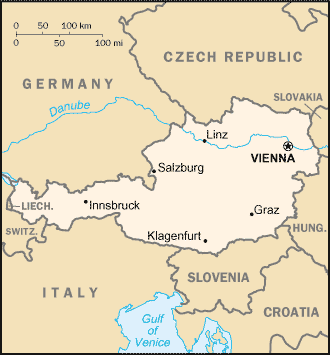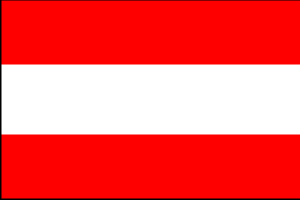
|
Austria
Background:
Once the center of power for the large Austro-Hungarian Empire,
Austria was reduced to a small republic after its defeat in World War I.
Following annexation by Nazi Germany in 1938 and subsequent occupation by the
victorious Allies in 1945, Austria's status remained unclear for a decade. A
State Treaty signed in 1955 ended the occupation, recognized Austria's
independence, and forbade unification with Germany. A constitutional law of
that same year declared the country's "perpetual neutrality" as a condition for
Soviet military withdrawal. This neutrality, once ingrained as part of the
Austrian cultural identity, has been called into question since the Soviet
collapse of 1991 and Austria's entry into the European Union in 1995. A
prosperous country, Austria entered the European Monetary Union in 1999.
Location:
Central Europe, north of Italy and Slovenia
Area: Total: 83,858 sq km water: 1,120 sq km land: 82,738 sq km
Area - comparative: Slightly smaller than Maine
Land boundaries: Total: 2,562 km border countries: Czech Republic 362 km,
Germany 784 km, Hungary 366 km, Italy 430 km, Liechtenstein 35 km, Slovakia 91
km, Slovenia 330 km, Switzerland 164 km
Climate and Terrain:
Climate: Temperate; continental, cloudy; cold winters with frequent rain in
lowlands and snow in mountains; cool summers with occasional showers
Terrain: In the west and south mostly mountains (Alps); along the eastern and
northern margins mostly flat or gently sloping
Natural resources: Iron ore, oil, timber, magnesite, lead, coal, lignite,
copper, hydropower
People:
Population: 8,169,929.
Ethnic groups: German 88%, non-nationals 9.3% (includes Croatians, Slovenes,
Hungarians, Czechs, Slovaks, Roma), naturalized 2%.
Religions: Roman Catholic 78%, Protestant 5%, Muslim and other 17%.
Languages: German.
Government:
Government type: Federal republic.
Capital: Vienna.
Independence: 1156 (from Bavaria).
Economy overview:
Austria, with its well-developed market economy and high standard of living,
is closely tied to other EU economies, especially Germany's. Membership in the
EU has drawn an influx of foreign investors attracted by Austria's access to
the single European market and proximity to EU aspirant economies. Slowing
growth in Germany and elsewhere in the world slowed the economy to only 1.2%
growth in 2001; the economy is expected to do little better in 2002. To meet
increased competition from both EU and Central European countries, Austria will
need to emphasize knowledge-based sectors of the economy, continue to
deregulate the service sector, and lower its tax burden.
GDP - composition by sector: Agriculture: 2% industry: 29% services: 69%.
Statistics:
Telephones - main lines in use: 4 million.
Telephones - mobile cellular: 6 million.
Radio broadcast stations: AM 2, FM 160.
Radios: 6.08 million.
Television broadcast stations: 45.
Televisions: 4.25 million.
Internet users: 3 million.
Railways: Total: 6,095.2 km.
Highways: Total: 133,361 km.
Airports - with paved runways: 24, with unpaved runways: 31.
Return to Visiting Locations
|

